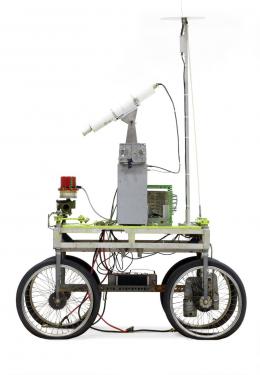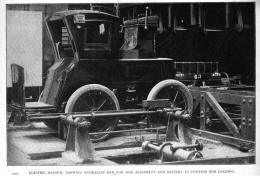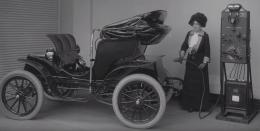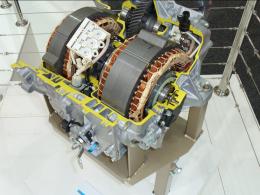




Just about every self-respecting carmaker and its mother are bragging nowadays about self-driving cars and autonomous technology. The truth is that a highly incipient form of an autonomous vehicle was made for the first time in 1964, in the form of the Stanford Artificial Intelligence Laboratory Cart. Not taking into account that it couldn't carry passengers, the Stanford Cart was a golf-cart-sized vehicle that relied on an onboard camera and wireless connection to a nearby computer.
A product of Stanford University's Artificial Intelligence Laboratory, the small cart would record video with the onboard camera and send the images to a nearby computer for processing. After analyzing the footage, the computer would compute sort of a 3D map of the surrounding environment and then transmit movement commands back to the cart.
Obviously, it was an excruciatingly long process involved just for a few feet of autonomous driving at a time, which is mainly why we've never had autonomous cars roaming our streets until the present day. Electric Car Battery Swapping Stations
Remember Better Place? It was a somewhat recent start-up that had an immensely bright future ahead, thanks to the then-sensational idea of bringing battery swapping technology to the masses. More recently, even Elon Musk toyed with the idea of fast battery swapping stations, despite the fact that a large-scale implementation may be sabotaged by Tesla's Supercharger network.
The premise behind battery swapping technology is simple: you park your electric car over an automatically or manually controlled system, which can open up the car's belly, remove the depleted battery, and replace it with a fully charged one.
The entire process should take less or as much as a trip to the gas station for a regular car owner, so it's easy to see the immediate benefits. In short, if enough battery swapping stations are built and if they are all standardized to accept any electric car, range anxiety will become a thing of the past.
Speaking of the past, it was neither Better Place nor Tesla that first tried this idea, since the technology is older than most carmakers. Back in the late 1890s, when both electric and steam vehicles were the norm, an American taxi company was operating a fleet of electric cabs with interchangeable batteries.
In short, after doing a reasonable amount of taxi runs, each vehicle returned to “base”, where its depleted lead-acid battery would be swapped for a fully charged one in a matter of minutes. Sadly, the New York-based “Electric Vehicle Company” went bust in under a decade, with both electric and steam-powered cars being slowly replaced by gasoline-powered ones thanks to the rise of gas stations around the world.Public Electric Car Chargers
Speaking of electric cars and their early market success, does anyone wonder how they were charged, especially since range anxiety had always been a problem? As it turns out, almost each electric carmaker back in the late 1800s and early 1900s had its own solution to this problem, most of them opting to either sell or lease a different type of charger for the car it produced. Interestingly enough, there aren't that many differences between Tesla's Supercharger network and its indirect ancestors.
Some electric car dealers had multiple charging spots at their locations, where the car owners would leave their cars to be charged. Others resorted to taking the entire battery out and charging multiple ones at the same time, then installing them back into the cars. Neither of these solutions provided any real answer to range anxiety, so others sold personal charging stations to electric vehicle owners.
Since that wasn't enough either, General Electric built a somewhat successful public charging network that consisted of “Electrants” (electric hydrants). The Electrants looked like telephone boxes and were spread in large urban environments, where electric car owners could park and charge their cars while doing errands.
Apparently, those charging poles would deliver energy at 10 cents per kWh. Their death resulted both from the rise of ICE-powered vehicles and the fact that then, like now, there was no global standard for charging sockets. This meant that only certain car models could use them, rendering them about as helpful as a Supercharger station is for a Nissan Leaf owner. Cylinder deactivation
Some think that the idea of a multi-cylinder engine to sometimes run with only part of its cylinders is a post-2000s technology that appeared on the 2005 Chrysler 300C. Others are under the impression that cylinder deactivation technology debuted even earlier, on the 2001 Mercedes-Benz S600 and CL600. All of them are wrong since the idea of improving fuel economy by simply stopping some of the cylinders in a running engine goes quite a bit earlier than that.
In 1981, Cadillac attempted almost to enforce the introduction of an innovative engine called the L62 “V8-6-4.” The company trusted the technology so much that it made it standard on every single Cadillac model of the time apart from the Seville.
In an effort to meet CAFE requirements for fuel economy without losing its V8,
the V8-6-4 technology was developed in cooperation with Eaton Corporation. The cylinder deactivation system was called Modulated Displacement, and it would shut off either two or four cylinders during sustained highway cruising.
Similar systems were tried by Alfa Romeo and Mitsubishi, but in the end neither of them proved to be as reliable as it should have been, prompting each carmaker to fold investments in the technology. Regenerative Braking and e-CVT
This technology definitely arrived at about the same time as modern hybrids and/or electric vehicles, right? Wrong. Early electric cars like the Baker Electric Runabout from 1904 actually used a pretty complicated form of regenerative braking that either returned some of the kinetic brake energy back into the batteries or simply helped with the car's overall braking.
As an early Electronic Continuous Variable Transmission (e-CVT) example, a number of luxury hybrids from Owen Magnetic (1915-1922) used an innovative drivetrain, which was based on a similar electromagnetic principle as a battleship from the time. In short, the internal combustion engine had no direct connection to the wheels, and there was no flywheel.
Instead, almost like the Toyota Prius' e-CVT system, an electric motor attached to the engine's generator would provide the energy to turn the driveshaft and subsequently the wheels. Instead of using a gas pedal, the vehicle's speed was controlled by a small lever that made the electric motor correlate its speed with that of the internal combustion engine in various degrees.








